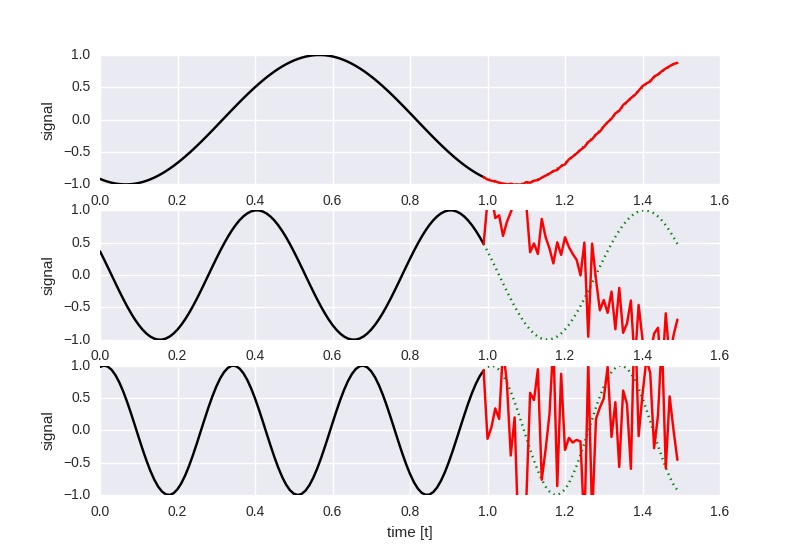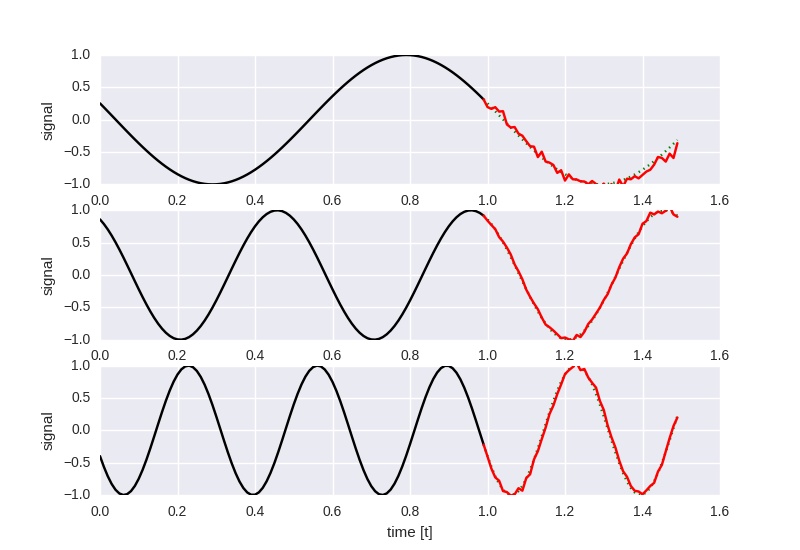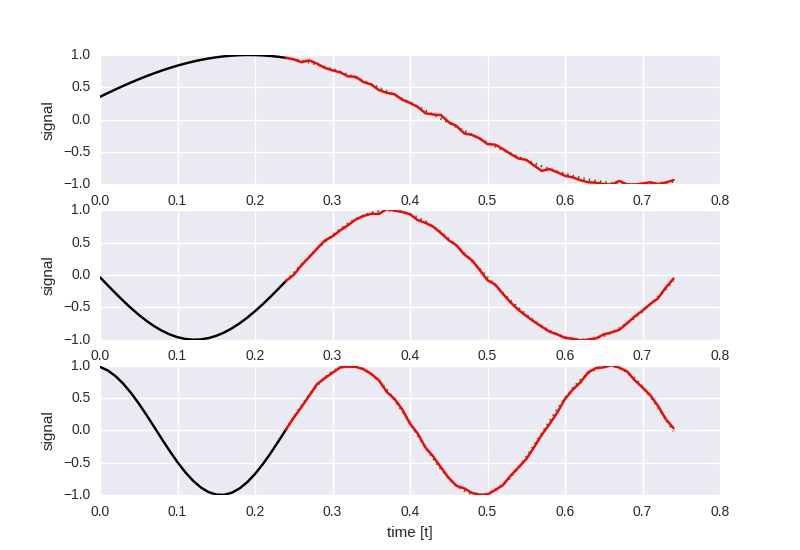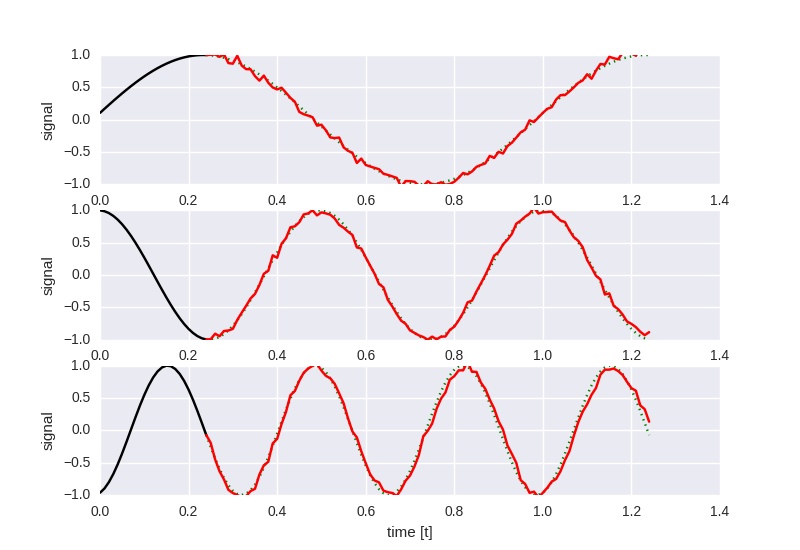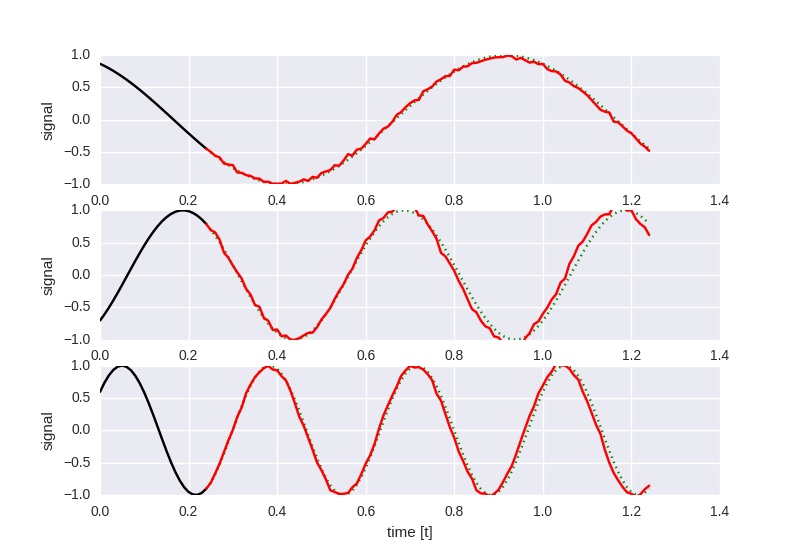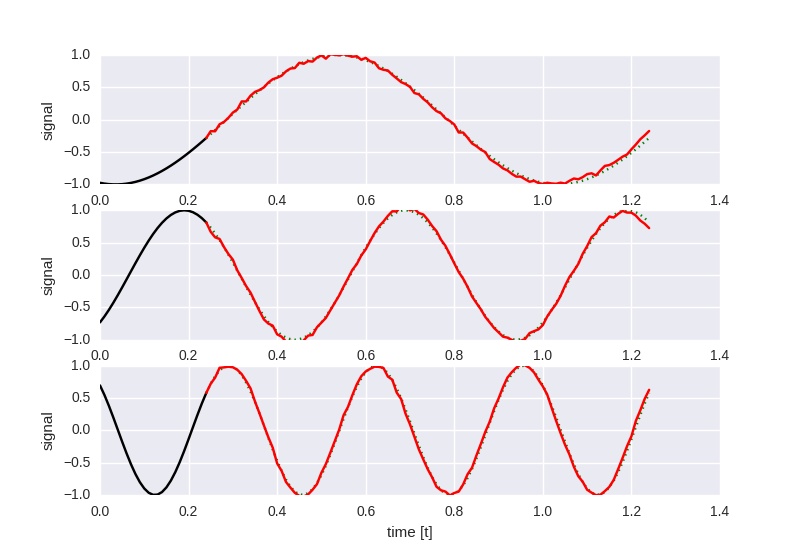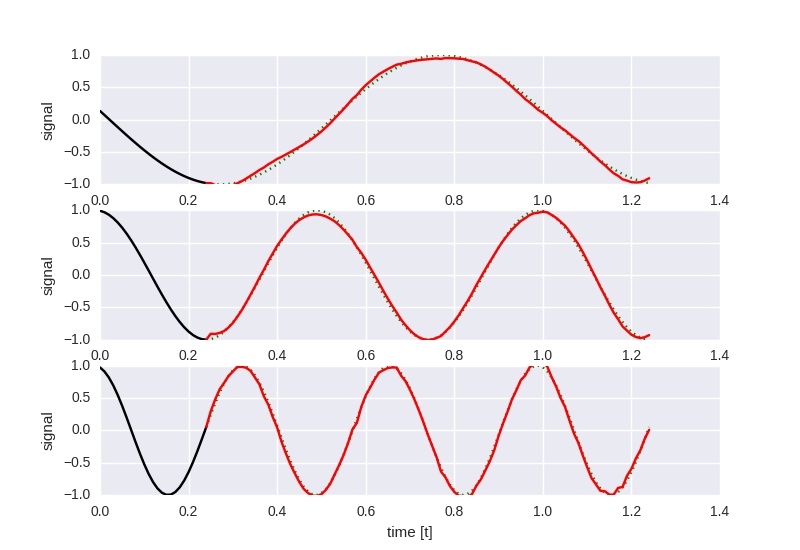sunsided / Tensorflow Lstm Sin
Programming Languages
Projects that are alternatives of or similar to Tensorflow Lstm Sin
TensorFlow LSTM sin(t) Example
Single- and multilayer LSTM networks with no additional output nonlinearity based on aymericdamien's TensorFlow examples and Sequence prediction using recurrent neural networks.
Experiments with varying numbers of hidden units, LSTM cells and techniques like gradient clipping were conducted using static_rnn and dynamic_rnn. All networks have been optimized using Adam on the MSE loss function.
Experiment 1
Given a single LSTM cell with 100 hidden states, predict the next 50 timesteps
given the last 100 timesteps.
The network is trained on a sine of 1 Hz only using random shifts, thus fails on
generalizing to higher frequencies (2 Hz and 3 Hz in the image); in addition, the
network should be able to simply memoize the shape of the input.
It was optimized with a learning rate of 0.001 for 200000 iterations and
batches of 50 examples.
Experiment 2
Given a single LSTM cell with 150 hidden states, predict the next 50 timesteps
given the last 100 timesteps.
The network is trained on sines of random frequencies between 0.5 .. 4 Hz using
random shifts. Prediction quality is worse than for the 1 Hz only experiment above,
but it generalizes to the 2 Hz and 3 Hz tests.
It was optimized with a learning rate of 0.001 for 300000 iterations and
batches of 50 examples.
At loss 0.614914, the prediction looks like this:
Experiment 3
Given a single LSTM cell with 150 hidden states, predict the next 50 timesteps
given the last 25 timesteps.
The network is trained on sines of random frequencies between 0.5 Hz and 4 Hz using
random shifts. Prediction quality is worse than for the 1 Hz only experiment above,
but it generalizes to the 2 Hz and 3 Hz tests.
It was optimized with a learning rate of 0.0005 for 500000 iterations and
batches of 50 examples.
The following image shows the output at loss 0.177742:
The following is the network trained to predict the next 100 timesteps
given the previous 25 timesteps; the parameters are otherwise unchanged.
This is the result at loss 0.257725:
Experiment 4
Same as the last experiment, however using 500 hidden states and gradient clipping
for the optimizer as described here:
adam = tf.train.AdamOptimizer(learning_rate=learning_rate)
gradients = adam.compute_gradients(loss)
clipped_gradients = [(tf.clip_by_value(grad, -0.5, 0.5), var) for grad, var in gradients]
optimizer = adam.apply_gradients(clipped_gradients)
Losses get as low as 0.069027 within the given iterations, but vary wildly.
This is at loss 0.422188:
Experiment 5
This time, the dynamic_rnn() function is used instead of rnn(), drastically improving the
startup time. In addition, the single LSTM cell has been replaced with 4 stacked
LSTM cells of 32 hidden states each.
lstm_cells = [rnn.LSTMCell(n_hidden, forget_bias=1.0)
for _ in range(n_layers)]
stacked_lstm = rnn.MultiRNNCell(lstm_cells)
outputs, states = tf.nn.dynamic_rnn(stacked_lstm, x, dtype=tf.float32, time_major=False)
The output still uses linear regression:
output = tf.transpose(outputs, [1, 0, 2])
pred = tf.matmul(output[-1], weights['out']) + biases['out']
The network is trained with learning rate 0.001 for at least 300000 iterations
(with the additional criterion that the loss should be below 0.15).
The following picture shows the performance at loss 0.138701 at iteration 375000.
When using only 10 hidden states, training takes much longer given a learning rate of 0.001
and reaches a loss of about 0.5 after ~1200000 iterations, where convergence effectively stops.
The following used 10 hidden states and a base learning rate of 0.005 in combination with a
step policy that reduced the learning rate by a factor of 0.1 every 250000 iterations.
Similar to the previous experiment, optimization was stopped after at least 300000 iterations
have passed and the loss was below 0.2.
The picture shows the outcome after 510000 iterations at a loss of 0.180995:
Experiment 6
Much like the last experiment, this one uses 10 hidden states per layer
in a 4 layer deep recurrent structure. Instead of using LSTM layers, however,
this one uses GRUs.
Because the loss did not go below 0.3, training was stopped after 1000000
iterations.

